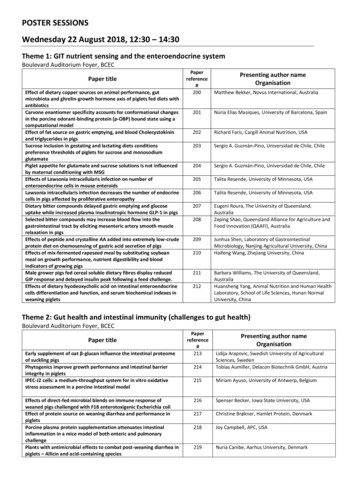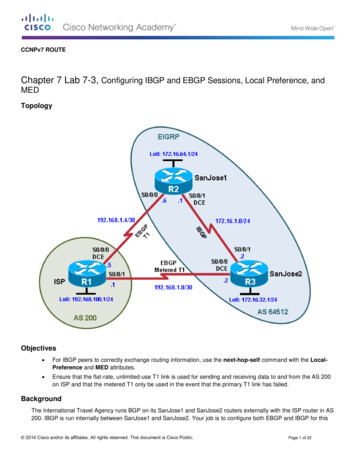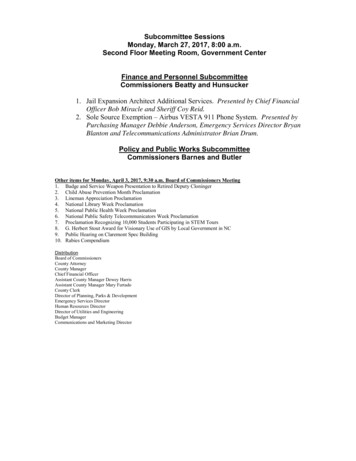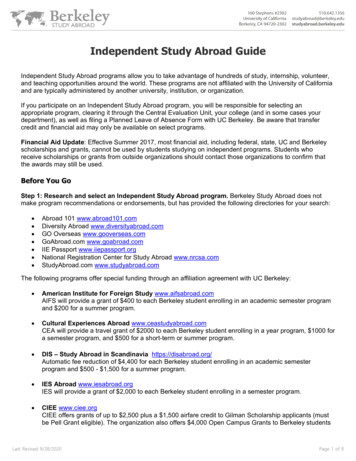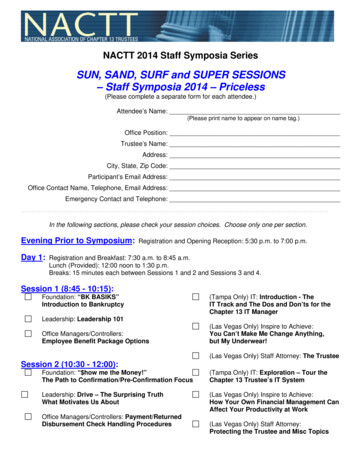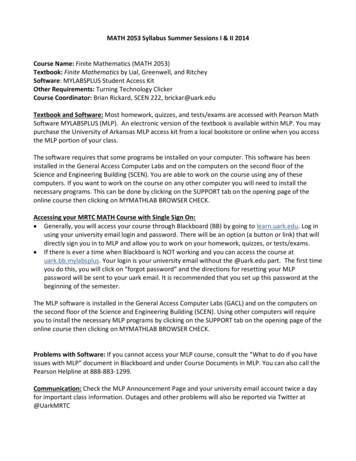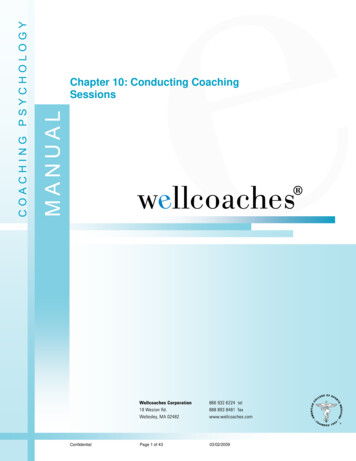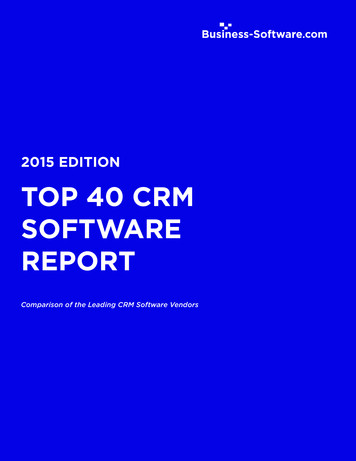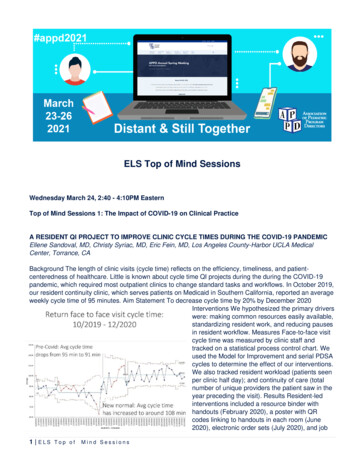
Transcription
ELS Top of Mind SessionsWednesday March 24, 2:40 - 4:10PM EasternTop of Mind Sessions 1: The Impact of COVID-19 on Clinical PracticeA RESIDENT QI PROJECT TO IMPROVE CLINIC CYCLE TIMES DURING THE COVID-19 PANDEMICEllene Sandoval, MD, Christy Syriac, MD, Eric Fein, MD, Los Angeles County-Harbor UCLA MedicalCenter, Torrance, CABackground The length of clinic visits (cycle time) reflects on the efficiency, timeliness, and patientcenteredness of healthcare. Little is known about cycle time QI projects during the during the COVID-19pandemic, which required most outpatient clinics to change standard tasks and workflows. In October 2019,our resident continuity clinic, which serves patients on Medicaid in Southern California, reported an averageweekly cycle time of 95 minutes. Aim Statement To decrease cycle time by 20% by December 2020Interventions We hypothesized the primary driverswere: making common resources easily available,standardizing resident work, and reducing pausesin resident workflow. Measures Face-to-face visitcycle time was measured by clinic staff andtracked on a statistical process control chart. Weused the Model for Improvement and serial PDSAcycles to determine the effect of our interventions.We also tracked resident workload (patients seenper clinic half day); and continuity of care (totalnumber of unique providers the patient saw in theyear preceding the visit). Results Resident-ledinterventions included a resource binder withhandouts (February 2020), a poster with QRcodes linking to handouts in each room (June2020), electronic order sets (July 2020), and job1 ELS Top of Mind Sessions
aids with required clinic tasks taped to computer monitors (August 2020). From October 2019 to November2020, the number of non-resident clinic staff did not change, but in April-June 2020 staff tasks andworkflows were revised to accommodate a shift to more phone visits, triage, and screening. Average cycletime shifted up from April to June 2020 and then settled at 108 minutes after June. From October 2019through December 2019, resident workload remained unchanged (4.4 patients per half day). Continuity ofcare did not change: patients had seen an average of 3.1 unique providers in the year preceding.Conclusions and Next Steps Resident interventions did not appear to impact cycle time as much aschanges in staff tasks and workflows. Resident QI projects to improve clinic cycle time should consider nonresident staff tasks and workflows as a key intervention target.CAREGIVER PERSPECTIVES ON COVID-19-RELATED CHANGES TO ROUNDING PRACTICESStephanie Harlow, MD, Ross Myers, MD, Case Western Reserve Univ/Univ Hosps Cleveland MedCtr/Rainbow Babies and Childrens Hospital, Cleveland, OHIntroduction: The COVID-19 pandemic forced hospitals to shift practices to comply with social distancingrecommendations. At Rainbow Babies and Childrens Hospital (RBCH), significant changes were made tomorning rounds. This study investigated the perceptions of Pediatric interns, senior residents, attendings,and nurses regarding these changes. Methods: The period of interest included the 2019-2020 academicyear, with focused comparison of rounds before and after March 15. Specific changes made to rounds atRBCH included: (1) computer-based pre-rounding only; (2) table rounding, rather than bedside; and (3)attending 1 resident in-person rounding, with physical exams being done by the resident. Retrospectivepre/post surveys included Likert-style and free-response questions assessing family-centeredness,communication, and educational aspects of rounds. Results: Surveys were distributed by email to 35interns, 41 senior residents, 67 attendings, and 86 nurses, with 8 interns (23%), 17 seniors (41%), 28attendings (42%), and 26 nurses (30%) responding. Forty-three percent of interns described increasedcomfort with revealing a knowledge gap, and 85.7% noted increased frequency of attendings observingtheir physical exam skills. Most nurses (79%) described communication with residents to be worse. Familycenteredness was globally described to be worse (interns: 100%, seniors: 71.4%, attendings: 90.9%,nurses: 100%). Conclusion: While aspects of resident education were perceived to improve, communicationand family-centeredness were perceived to worsen. These results indicate a need to consider how roundscould be adjusted to improve communication while retaining the positive perceived educational experiences,even in the post-COVID era.CULTIVATING 'WEBSIDE MANNER' IN THE GME TELEMEDICINE LEARNERRoya Samuels, MD, Zucker School of Medicine at Hofstra/Northwell at Cohen Children's Medical Center,Great Neck, NY, Stacy McGeechan, MD, Stephen Barone, MD, Erin Allmer, MD, Stephanie Sayres, DO,Joesph Castiglione, MD, Zucker School of Medicine at Hofstra/Northwell at Cohen Children's MedicalCenter, New Hyde Park, NYBACKGROUND. The 2020 COVID-19 pandemic forced a rapid surge in the burgeoning health care field oftelemedicine. 'Webside manner', the counterpart to 'bedside manner', is a distinct communication skillrequiring particular instruction which traditional medical education may not afford. A critical window ofinstructional opportunity in the use of telemedicine exists at the GME level. METHODS. During the swell ofthe 2020 COVID-19 pandemic, we at Cohen Children's Medical Center quickly worked to formalizetelemedicine training for our incoming Pediatric trainees. Telemedicine education literature was exploredand adapted to create a self-directed, five unit online curriculum. Evaluation of our curriculum involvedassessment of communication skills of our incoming pediatric interns (n 33). These interns acted astelemedicine providers on a baseline mock virtual encounter and were then randomly assigned to either the2 ELS Top of Mind Sessions
intervention (telemedicine curriculum) or control group (no curriculum). The intervention group was givenone week to complete the curriculum. Both groups were then invited for another observed telemedicineencounter. A 'Communication Checklist', a measurement tool created to assess communication skills on avirtual platform, was used to evaluate each intern on eight communication skills during their sessions.RESULTS. Results from independent t-tests demonstrated a statistically significant improvement (P .001)in total scores of interns who completed our telemedicine curriculum (Delta 3.6; R .627, p .007). Incomparison, scores of those who did not complete the curriculum (Delta 0.9; P .074) did not showsignificant improvement (p .074). Post-curriculum participants' scores increased significantly in categoriesof privacy assurance, rapport establishment, demonstration of empathy and partnership-building.DISCUSSION. Our formalized training significantly improved core communication skills in our telemedicinelearners. Areas of improvement include: assessing interrater reliability in use of our 'CommunicationChecklist Tool', as well as testing our tool with a larger cohort of interns for more robust results.DEPLOYMENT OF PEDIATRIC TRAINEES DURING THE COVID-19 PANDEMIC IN NYC:PERSPECTIVES, REFLECTIONS AND LESSONS LEARNEDCynthia J. Katz, MD, Emily Hertzberg, MD, Sonali Tatapudy, MD, Lindsey C. Douglas, MD, Diana S. Lee,MD, Stephanie Pan, MS, Karen M. Wilson, MD, Laura N. Hodo, MD, Icahn School of Medicine at MountSinai (Kravis Children's), New York, NYBACKGROUND: In April 2020, the COVID-19 pandemic brought a surge of adult patients to our New YorkCity hospital, creating the need to reassign providers to COVID units. Pediatric trainees were deployed tointernal medicine teams; 41% of residents and 25% of fellows were deployed. Objective: To understand theperception and experience of pediatric trainees before and after deployment. METHODS: Pre-deploymentsurveys were sent to all pediatric trainees (n 140), and post-deployment surveys were sent to deployedtrainees (n 29). Surveys assessed demographics, fears, deployment details, and reflections. Descriptivedata was reported as frequency and percentage and median and interquartile range where appropriate.Responses were analyzed to assess association between residents and fellows, living situation, anddeployment details. For free text responses, authors independently performed an inductive approach tothematic analysis to form codes, and came to consensus on themes. RESULTS: Pre and post deploymentsurvey response rates were 39% and 72%, respectively. Pre-deployment, 74% of trainees feltuncomfortable taking care of adults, while 81% felt uncomfortable post-deployment. The most frequentlyreported fears were not knowing enough about general medicine (78%), getting sick (64%), working withunfamiliar people (57%), bringing home illness to family (52%) and running out of PPE (52%). Four themesemerged from free text responses: harm to self, harm to loved ones, harm to patients, and unfamiliarculture. Trainees expressed a desire for more predictability and logistical knowledge in preparation fordeployment. They reflected positively on camaraderie, teamwork and supportive working environment.CONCLUSION: In anticipation of deployment to adult COVID units pediatric trainees had fears aboutmedical knowledge gaps and personal and family safety, which persisted post deployment. Lack ofpredictability and logistical knowledge were also concerns. Trainee concerns may be mitigated by moreconsistent and proactive communication, targeted training, and specific support around safety.TELEMEDICINE IN PEDIATRIC RESIDENCY TRAINING: A NATIONAL NEEDS ASSESSMENTMelissa Fitzgerald, MD, Nicole Paradise Black, MD, MEd, Jaclyn Otero, MD, University of Florida,Gainesville, FL, Lindsay A. Thompson, MD, MS, University of Florida, Florida, FL, Dana A. Schinasi, MD,McGaw Medical Center of Northwestern University, Chicago, IL, Pamela Carpenter, MED, University ofUtah, Salt Lake City, UT, Avni Bhatt, PhD, University of California (Davis) Health System, Sacramento, CA,Aaron O. Thomas, PhD, Julie S. Thomas, MEd, University of Florida, Gainesville, FL3 ELS Top of Mind Sessions
Background: Prior to the COVID-19 pandemic, telemedicine use was gaining momentum in clinicsnationwide and in the wake of COVID-19, numerous institutions rapidly adopted this care modality. As aresult, graduate medical education (GME) programs increased trainee utilization of telemedicine. Given thisincreased use it is imperative that pediatric GME programs provide adequate training in the responsible useof telemedicine. Objective: To describe the current state of telemedicine in residency training in order toinform next steps in developing a national telemedicine training curriculum for pediatric trainees. Methods:We conducted an anonymous cross-sectional survey of pediatric residency program directors from October2020 to December 2020 through the APPD Research and Scholarship Learning Community on the currentstate of telemedicine in pediatric residency training. We used descriptive statistics to quantify telemedicineuse and settings, both prior to and since the COVID-19 pandemic, as well as to discern providerperceptions of important aspects of and limitations to implementing a telemedicine curriculum. Results: Atotal of 48 (24%) U.S. pediatric residency programs completed the survey with responses from programs ineach of the eight APPD regions. Pre-COVID-19, 4% of respondents utilized telemedicine. Post-COVID-19,92% used telemedicine with the most common settings for use by trainees in the longitudinal outpatientexperience (78%) and subspecialty clinics (85%). Almost 90% of respondents agreed that a formalizedtelemedicine curriculum is important, but more than 52% reported not yet having a curriculum. Expandingaccess to care was ranked by 78% of respondents as a "Very Important" or "Important"reason forcurriculum implementation. Respondents ranked the following topics as the most important for atelemedicine curriculum: provider-patient interactions, scope of care, scope of exam, appropriatedocumentation, and ensuring patient confidentiality. Eighteen percent of respondents were unsure/not likelyto add a telemedicine curriculum to their program citing barriers such as: time (66%), cost (66%), andlogistics (44%). Conclusions: Our needs assessment indicates significant increase in the use oftelemedicine by pediatric GME programs with less than half the respondents having a formalized trainingcurriculum. Telemedicine presents a unique opportunity to expand care as a complement to in person care,and most agreed that a curriculum is important to facilitate this expanded access. Therefore, it is imperativethat pediatric trainees are educated and trained on the unique challenges and appropriate use oftelemedicine. While some programs reported lack of interest in a pediatric telemedicine curriculum, thebarriers reported (time, cost, and logistics) can be overcome by a national, open-source pediatrictelemedicine curriculum, such as the Telemedicine in Pediatric Training program (TIPT), which will begin itspilot in January 2021.Wednesday March 24, 2:40 - 4:10PM EasternTop of Mind Session 2: Strategies for Maintaining Mental Health and Mitigating BurnoutHOW DO ORGANIZATIONAL AND ENVIRONMENTAL FACTORS SHAPE RESIDENT PERCEPTIONSOF BURNOUT AND WELLNESS DURING THEIR PEDIATRIC INTENSIVE CARE UNIT (PICU)ROTATION? A MULTI-CENTER QUALITATIVE STUDYRebecca J. Jacobowitz, MD, New York Presbyterian Hospital (Cornell Campus), New York, NY, JenniferShenker, MD, New York University School of Medicine, Megan Toal, MD, New York Presbyterian Hospital(Cornell Campus), Laura Schroeder, MD, New York University School of Medicine, Erika Abramson, MD,New York Presbyterian Hospital (Cornell Campus), NY, NYBackground: Burnout and compassion fatigue is known to affect physicians and nurses working in thecritical care setting, with some of the highest rates amongst those in pediatric critical care. Both cannegatively impact provider mental health and patient care outcomes. Identifying modifiable environmentalfactors contributing to burnout, rather than individual provider characteristics, is emerging as a strategy to4 ELS Top of Mind Sessions
mitigate burnout and compassionfatigue in the critical careenvironment. While all pediatricsresidents must rotate in the pediatricintensive care unit (PICU), it is notknown how the rotation should bestructured from the perspective ofoptimizing resident education and tominimize the risk of burnoutsyndrome. Objective: To identifymodifiable factors related to residentperceptions of burnout and wellnessduring the PICU rotation.Design/Methods: We conductedsemi-structured interviews of 28pediatrics residents from 9 differentresidency programs in the New Yorkand New Jersey region. We usedconstant comparison analysis toderive themes from interviews untilachieving thematic saturation.Results: The residents who wereinterviewed represented a variety ofprogram sizes and post-residencycareer interests. We identified 4themes representing strategies toreduce resident perceptions ofburnout and improve perception ofwellness and education (Table). These themes included: 1) Fostering a culture of education by emphasizingpatient-based teaching and resident autonomy in decision-making while minimizing tasks that pull residentsaway from the bedside; 2) Recognition of the resident as a part of the PICU team by providing dedicatedwork space, resident-focused debriefings following patient death and limiting patient load to maintain safety(ideally 6 patients per resident); 3) Facilitating relationships between residents and regular unit-staff,enforcing residents as first callfor patients; and 4) Helping residents find meaning through their inclusion infamily discussions and interactions. Conclusion: Attention to the resident experience in the PICU isimportant given the risks of burnout syndrome in worsening resident mental health and on patientoutcomes. This study highlights strategies identified by residents with varying career interests that can beused by pediatric educators to best support pediatrics residents during the PICU rotation.IMPACT OF NARRATIVE MEDICINE CURRICULUM ON BURNOUT IN PEDIATRIC CRITICAL CARETRAINEESJessica C. Becker, MD, Mindy Dickerman, MD, Nemours Children's Hospital Program, Wilmington, DEIntroduction/hypothesis: Intensive care units have staff burnout levels reported to be as high as 47%. Arecent study demonstrated high levels of burnout in pediatric intensive care unit (PICU) trainees. Thepractice of narrative medicine is one potential intervention to mitigate burnout. Narrative medicine couldhelp medical trainees foster empathy and resilience, and renew compassion. While many narrativeprograms exist in medical training, there are no studies describing a narrative curriculum for PICU fellows.5 ELS Top of Mind Sessions
There are also few studies evaluating the effect of such programs on burnout. We hypothesized that anarrative medicine program is feasible to incorporate into the curriculum of a PICU fellowship, and that it willimprove validated burnout metrics in ICU trainees. Methods: The primary fellow investigator developed aliterary curriculum for all of our PICU fellows (total of eight fellows). Each fellow completed baseline burnoutevaluations, the abbreviated Maslach Burnout Inventory (aMBI) and the Professional Quality of Life Scaleversion 5 (ProQOL5). Each month, participants read a short narrative with group discussion facilitated bythe primary fellow investigator. Fellows provided qualitative evaluation at the end of each session. Validatedburnout scores and curriculum feedback were collected at the end of the study. Results: Narrative medicinewas a feasible addition to the fellowship curriculum, with 87.5% reporting they enjoyed the sessions. Whenasked if these sessions influenced their capacity to respond to peers, 62.5% responded favorably. Only37.5% perceived that these sessions helped them respond to patients. Interestingly, qualitative feedbacksuggested sessions were more enjoyable and more appreciated after the start of the Covid-19 pandemic.aMBI average Emotional Exhaustion scores decreased, from 8 to 5.75 (p 0.001) and Depersonalizationscores also decreased. Personal Accomplishment and Satisfaction scores increased. In addition, ProQOLBurnout and Secondary Trauma scores decreased. Compassion scores were unchanged. Conclusions: Anarrative medicine curriculum is feasible and accepted within the educational structure of a PICU fellowshipprogram. Burnout metrics improved after participation in the narrative medicine sessions. Further evaluationwith a larger sample size is warranted.INVESTIGATING DRIVERS OF BURNOUT AMONG PEDIATRIC FELLOWSHIP TRAINEESColleen E. Bennett, MD, MSHP, Marissa J. Kilberg, MD, MSEd, Dorene Balmer, PhD, Jay Mehta, MD,MSEd, Anna Weiss, MD, MSEd, Children's Hospital of Philadelphia, Philadelphia, PABackground/Objective: Factors contributing to burnout among pediatric fellows are poorly characterized;consequently, how to address their burnout is not well-understood. Based on pilot data from our institutiondemonstrating 50% of pediatric subspecialty fellows meet the threshold for burnout, we sought to exploredrivers of burnout and wellness among fellows using qualitative methodology. We also sought tounderstand their perceptions of the impact of COVID-19 on their wellness. Methods: We conducted focusgroups with a convenience sample of pediatric fellows at our freestanding tertiary-care children's hospital.We facilitated focus groups using a semi-structured interview guide. Focus groups were recorded,transcribed, and de-identified. Using thematic analysis principles, we inductively derived codes, appliedcodes to data segments, and iteratively scrutinized coded data to identify emerging themes emphasizingprotective factors for wellness, and avoidable and unavoidable drivers of burnout based on the study's6 ELS Top of Mind Sessions
conceptual framework. Results: We conducted 9 focus groups with
1 E L S T o p o f M i n d S e s s i o n s ELS Top of Mind Sessions Wednesday March 24, 2:40 - 4:10PM Eastern Top of Mind Sessions 1: The Impact of COVID-19 on Clinical Practice A RESIDENT QI PROJECT T


